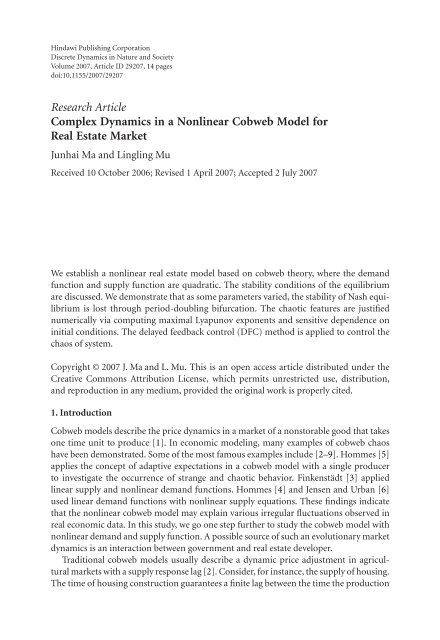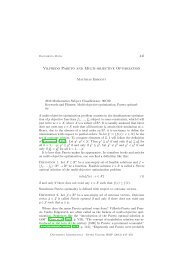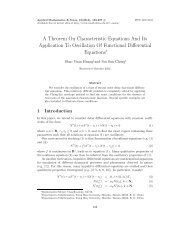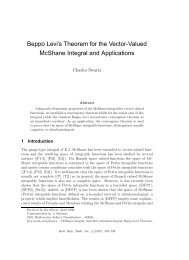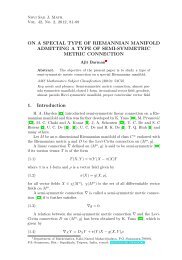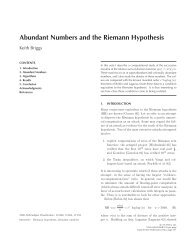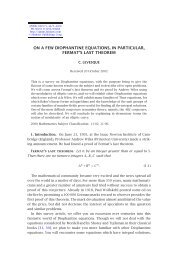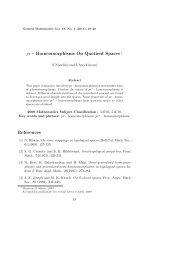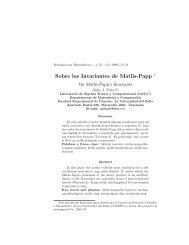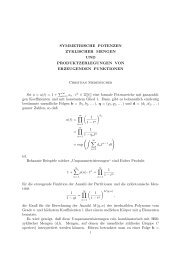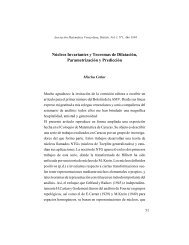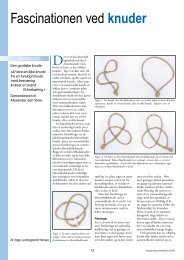Research Article Complex Dynamics in a Nonlinear Cobweb Model ...
Research Article Complex Dynamics in a Nonlinear Cobweb Model ...
Research Article Complex Dynamics in a Nonlinear Cobweb Model ...
You also want an ePaper? Increase the reach of your titles
YUMPU automatically turns print PDFs into web optimized ePapers that Google loves.
H<strong>in</strong>dawi Publish<strong>in</strong>g Corporation<br />
Discrete <strong>Dynamics</strong> <strong>in</strong> Nature and Society<br />
Volume 2007, <strong>Article</strong> ID 29207, 14 pages<br />
doi:10.1155/2007/29207<br />
<strong>Research</strong> <strong>Article</strong><br />
<strong>Complex</strong> <strong>Dynamics</strong> <strong>in</strong> a Nonl<strong>in</strong>ear <strong>Cobweb</strong> <strong>Model</strong> for<br />
Real Estate Market<br />
Junhai Ma and L<strong>in</strong>gl<strong>in</strong>g Mu<br />
Received 10 October 2006; Revised 1 April 2007; Accepted 2 July 2007<br />
We establish a nonl<strong>in</strong>ear real estate model based on cobweb theory, where the demand<br />
function and supply function are quadratic. The stability conditions of the equilibrium<br />
are discussed. We demonstrate that as some parameters varied, the stability of Nash equilibrium<br />
is lost through period-doubl<strong>in</strong>g bifurcation. The chaotic features are justified<br />
numerically via comput<strong>in</strong>g maximal Lyapunov exponents and sensitive dependence on<br />
<strong>in</strong>itial conditions. The delayed feedback control (DFC) method is applied to control the<br />
chaos of system.<br />
Copyright © 2007 J. Ma and L. Mu. This is an open access article distributed under the<br />
Creative Commons Attribution License, which permits unrestricted use, distribution,<br />
and reproduction <strong>in</strong> any medium, provided the orig<strong>in</strong>al work is properly cited.<br />
1. Introduction<br />
<strong>Cobweb</strong> models describe the price dynamics <strong>in</strong> a market of a nonstorable good that takes<br />
onetimeunittoproduce[1]. In economic model<strong>in</strong>g, many examples of cobweb chaos<br />
have been demonstrated. Some of the most famous examples <strong>in</strong>clude [2–9]. Hommes [5]<br />
applies the concept of adaptive expectations <strong>in</strong> a cobweb model with a s<strong>in</strong>gle producer<br />
to <strong>in</strong>vestigate the occurrence of strange and chaotic behavior. F<strong>in</strong>kenstädt [3] applied<br />
l<strong>in</strong>ear supply and nonl<strong>in</strong>ear demand functions. Hommes [4] and Jensen and Urban [6]<br />
used l<strong>in</strong>ear demand functions with nonl<strong>in</strong>ear supply equations. These f<strong>in</strong>d<strong>in</strong>gs <strong>in</strong>dicate<br />
that the nonl<strong>in</strong>ear cobweb model may expla<strong>in</strong> various irregular fluctuations observed <strong>in</strong><br />
real economic data. In this study, we go one step further to study the cobweb model with<br />
nonl<strong>in</strong>ear demand and supply function. A possible source of such an evolutionary market<br />
dynamics is an <strong>in</strong>teraction between government and real estate developer.<br />
Traditional cobweb models usually describe a dynamic price adjustment <strong>in</strong> agricultural<br />
markets with a supply response lag [2]. Consider, for <strong>in</strong>stance, the supply of hous<strong>in</strong>g.<br />
The time of hous<strong>in</strong>g construction guarantees a f<strong>in</strong>ite lag between the time the production
2 Discrete <strong>Dynamics</strong> <strong>in</strong> Nature and Society<br />
decision is made and the time the hous<strong>in</strong>g is ready for sale. The real estate developer’s decision<br />
about how many houses should be built and sale is usually based on current and<br />
past experience. This pr<strong>in</strong>ciple is the same as that of agricultural product. So it is feasible<br />
to <strong>in</strong>troduce cobweb model <strong>in</strong>to real estate market.<br />
The present paper attempts to establish a nonl<strong>in</strong>ear model for the real estate market,<br />
and <strong>in</strong>troduce adjustment parameters of hous<strong>in</strong>g price and land price <strong>in</strong>to the model,<br />
which can denote the game behavior of players. The system stability with the variation<br />
of parameters is analyzed. Numerical simulations verify the complexity of system evolvement.<br />
F<strong>in</strong>ally, time-delayed feedback control method is used to keep the system from<br />
chaos and bifurcation.<br />
2. Nonl<strong>in</strong>ear models for real estate market<br />
In this paper we assume that all real estate developers <strong>in</strong> the market are belong to one benefit<br />
group and have a common benefit target. Usually the price p is characterized by the<br />
nonl<strong>in</strong>ear <strong>in</strong>verse demand function of p = a − b � Q,wherea and b are positive constants,<br />
a is the maximum price <strong>in</strong> the market, and Q is the total quantity <strong>in</strong> the market. This k<strong>in</strong>d<br />
of form has been used <strong>in</strong> other oligopoly models and <strong>in</strong> the experimental economics deal<strong>in</strong>g<br />
with learn<strong>in</strong>g and expectations formation (see, e.g., [10–12]). The transformation of<br />
this formula is as follows:<br />
D1(t) = b0 − b1 p1(t)+b2 p1 2 (t), D2(t) = c0 − c1 p2(t)+c2 p2 2 (t), (2.1)<br />
where b0, b1, b2, c0, c1, c2 are positive constants, p1(t) is the land price at time period t,<br />
p2(t) is the hous<strong>in</strong>g price at time period t, D1(t) is the land demand at time period t,<br />
and D2(t) is the hous<strong>in</strong>g demand at time period t. Due to the law of demand that the<br />
slope of demand curve is negative, the prices p1(t) andp2(t) must, respectively, satisfy<br />
the <strong>in</strong>equalies: 2b2 p1(t) − b1 < 0and2c2p2(t) − c1 < 0; 4b2b0 − b 2 1 > 0, 4c2c0 − c 2 1 > 0must<br />
hold, thus the signs of demand equations <strong>in</strong> formula (2.1) are positive.<br />
In this case, the land market and hous<strong>in</strong>g market are <strong>in</strong>terrelated. Though the hous<strong>in</strong>g<br />
market does not directly affect land market, the land price impacts the hous<strong>in</strong>g supply<br />
which decreases with <strong>in</strong>creas<strong>in</strong>g land price. This rule is the same as that of hog and corn<br />
as stated by Waugh [13]. Real estate companies adjust the hous<strong>in</strong>g supply accord<strong>in</strong>g to<br />
the relative policies and the situation of hous<strong>in</strong>g price and land price. The formula of<br />
supply can be supposed as follows:<br />
S1(t) = e0 + e1 p1(t)+e2p1 2 (t), S2(t) = d0 + d1 p2(t)+d2 p2 2 (t) − d3 p1(t), (2.2)<br />
where d0, d1, d2, d3, e0, e1, e2 are positive constants, S1(t)isthelandsupplyattimeperiod<br />
t,andS2(t) is the hous<strong>in</strong>g supply at time period t. Because 2e2p1(t)+e1 >0and2d2 p2(t)+<br />
d1 > 0, so we can affirm that the slope of supply curve is positive, and it is <strong>in</strong> accordance<br />
with the law of supply. Providers beg<strong>in</strong> to supply the products only when<br />
p1(t) > −e1 + � e1 2 − 4e2e0<br />
, p2(t) ><br />
2e2<br />
−d1<br />
�<br />
+<br />
2d2<br />
d1 2 − 4d2d0<br />
. (2.3)
Def<strong>in</strong>e<br />
J. Ma and L. Mu 3<br />
Z(p) = D(p) − S(p). (2.4)<br />
Z(p) is excess demand function descend<strong>in</strong>g with price, which denotes the gap between<br />
demand and supply. When the price is low, excess demand exists and when the price is<br />
high, excess supply exists, thus p∗ that satisfies the equation Z(p ∗ ) = 0 is called equilibrium<br />
po<strong>in</strong>t.<br />
Substitut<strong>in</strong>g (2.1)and(2.2)<strong>in</strong>to(2.4), we obta<strong>in</strong><br />
Z � p1(t) � = b0 − e0 − � �<br />
e1 + b1 p1(t)+ � �<br />
b2 − e2 p1 2 (t)<br />
Z � p2(t) � = c0 − d0 − � �<br />
d1 + c1 p2(t)+ � �<br />
c2 − d2 p2 2 t = 0,1,2,.... (2.5)<br />
(t)+d3 p1(t),<br />
S<strong>in</strong>ce Z(p) follows the law of demand, the follow<strong>in</strong>g conditions must hold:<br />
b2 − e2 > 0,<br />
c2 − d2 > 0,<br />
2 � �<br />
c2 − d2 p2(t) − � �<br />
d1 + c1 < 0,<br />
2 � �<br />
b2 − e2 p1(t) − � �<br />
e1 + b1 < 0.<br />
(2.6)<br />
α1 is the adjustment parameter of land price, which denotes the adjustment degree of<br />
benchmark land price controlled by government through the land supply plan. α2 is the<br />
adjustment parameter of hous<strong>in</strong>g price, the dynamic model of land price and hous<strong>in</strong>g<br />
price can be established as follows:<br />
p1(t) = p1(t − 1) + α1Z � p1(t − 1) � ,<br />
p2(t) = p2(t − 1) + α2Z � p2(t − 1) � ,<br />
t = 0,1,2,..., (2.7)<br />
where α1 and α2 are positive parameters.<br />
It is clear that the excess functions of land and hous<strong>in</strong>g with adjustment parameters<br />
are two-dimensional nonl<strong>in</strong>ear map, which can be regarded as a discrete dynamic system.<br />
3. Stability analysis<br />
3.1. Bifurcation and chaos. Expansion formula of (2.7)is:<br />
�<br />
p1(t)= p1(t − 1) + α1 b0 − e0 − � �<br />
e1 + b1 p1(t − 1) + � �<br />
b2 − e2 p1 2 (t − 1) � ,<br />
�<br />
p2(t)=p2(t−1)+α2 c0−d0− � �<br />
d1+c1 p2(t−1)+ � �<br />
c2−d2 p2 2 (t−1)+d3p1(t−1) � ,<br />
Let<br />
� �<br />
α1 e2 − b2<br />
u = �<br />
�e1 �2 � �� �<br />
1+α1 + b1 − 4 e0 − b0 e2 − b2<br />
,<br />
U = 1 1<br />
−<br />
2 2 ·<br />
� �<br />
1 − α1 e1 + b1<br />
�<br />
�e1 �2 � �� � , x(t) = up1(t)+U.<br />
1+α1 + b1 − 4 e2 − b2 e0 − b0<br />
t =0,1,2,....<br />
(3.1)<br />
(3.2)
4 Discrete <strong>Dynamics</strong> <strong>in</strong> Nature and Society<br />
Thetransformofthefirstequation<strong>in</strong>formula(3.1) is:<br />
x(t) = λx(t − 1) � 1 − x(t − 1) � , (3.3)<br />
�<br />
where λ = 1+α1 (e1 + b1) 2 − 4(e2 − b2)(e0 − b0). The stability of x(t) variesalongwith<br />
variety of λ accord<strong>in</strong>g to Logistic rule.<br />
If α1 < 0, then λ
Lemma 3.1. The equilibrium<br />
E1<br />
� b1+e1+<br />
��b1+e1 � � �� �<br />
2−4 e2−b2 e0−b0<br />
2 � � ,<br />
b2−e2<br />
d1+c1+<br />
J. Ma and L. Mu 5<br />
��d1+c1 � � ��<br />
2−4 c2 − d2 c0 − d0 + d3 p1<br />
2 � �<br />
c2 − d2<br />
� �<br />
(3.6)<br />
is an unstable equilibrium po<strong>in</strong>t.<br />
Proof. In order to prove this result, we f<strong>in</strong>d the eigenvalues of the Jacobian matrix J. In<br />
fact at E1, the Jacobian matrix becomes a triangular matrix:<br />
�<br />
J � E1<br />
⎡<br />
⎢<br />
= ⎣ 1+α1<br />
��b1+e1 �2−4� �� �<br />
e2−b2 e0−b0<br />
�1/2<br />
α2d3<br />
��d1+c1 �2−4� 1+α2<br />
c2−d2<br />
whose eigenvalues are given by the diagonal entries. They are:<br />
�� �2 � �� ��1/2, λ1 = 1+α1 b1 + e1 − 4 e2 − b2 e0 − b0<br />
�� �2 � �� ��1/2. λ2 = 1+α2 d1 + c1 − 4 c2 − d2 c0 − d0 + d3 p1<br />
0<br />
�� c0−d0+d3 p1<br />
⎤<br />
�� ⎥<br />
⎦<br />
1/2<br />
(3.7)<br />
(3.8)<br />
It is clear that when condition (3.5) holds,then|λ1| > 1and|λ2| > 1. Then E1 is an unstable<br />
equilibrium po<strong>in</strong>t of the system (3.1). This completes the proof of the proposition.<br />
The stability of other po<strong>in</strong>ts can also be judged by the above method. �<br />
3.3. The stable region of equilibrium po<strong>in</strong>t. In this subsection, we analyze the asymptotic<br />
stability of the equilibrium po<strong>in</strong>t for the two-dimensional map (3.1). We determ<strong>in</strong>e<br />
the region of stability <strong>in</strong> the plane of the parameters (α1,α2). The Jacobian matrix at<br />
E ∗ (p1 ∗ (t), p2 ∗ (t)) takes the form<br />
� � � � �<br />
1 − α1 e1 + b1 +2α1 b2 − e2 p1<br />
J =<br />
∗ (t) 0<br />
� � � �<br />
α2d3<br />
1 − α2 d1 + c1 +2α2 c2 − d2 p2 ∗ �<br />
.<br />
(t)<br />
(3.9)<br />
The characteristic equation of the matrix (3.9)hastheform<br />
F(λ) = λ 2 − Tr λ +Det= 0, (3.10)<br />
where “Tr” is the trace and “Det” is the determ<strong>in</strong>ant of the Jacobian matrix (3.9) which<br />
are given by<br />
� � � �<br />
Tr = 2 − α1 e1 + b1 +2α1 b2 − e2 p1 ∗ � � � �<br />
(t) − α2 d1 + c1 +2α2 c2 − d2 p2 ∗ (t),<br />
� � � �<br />
Det = 1 − α1 e1 + b1 +2α1 b2 − e2 p1 ∗ � � � �<br />
(t) − α2 d1 + c1 +2α2 c2 − d2 p2 ∗ (t)<br />
+ � � � � �<br />
α1 e1 + b1 − 2α1 b2 − e2 p1 ∗ (t) �� � � � �<br />
α2 d1 + c1 − 2α2 c2 − d2 p2 ∗ (t) � .<br />
(3.11)
6 Discrete <strong>Dynamics</strong> <strong>in</strong> Nature and Society<br />
S<strong>in</strong>ce<br />
(Tr) 2 −4Det= � � � � � � �<br />
α2 d1+c1 −α1 e1 + b1 +2α1 b2 − e2 p1 ∗ � �<br />
(t) − 2α2 c2 − d2 p2 ∗ (t) �2 > 0,<br />
(3.12)<br />
we deduce that the eigenvalues of equilibrium are real. The local stability of equilibrium<br />
po<strong>in</strong>t is given by Jury’s conditions [14, 15] which are as follows.<br />
(a) 1 − Tr + Det > 0.<br />
Lemma 3.2. The condition (a) is always satisfied.<br />
Proof. Because 1 − Tr + Det = [α1(e1 + b1) − 2α1(b2 − e2)p1 ∗ (t)][α2(d1 + c1) − 2α2(c2 −<br />
d2)p2 ∗ (t)], moreover, the last two conditions <strong>in</strong> (2.6) arehold,α1and α2 are positive<br />
parameters, so the sign of “1 − Tr+Det” is positive and the lemma is proven.<br />
(b) 1 + Tr+Det > 0,<br />
� � � �<br />
1+Tr+Det= 4 − 2α1 e1 + b1 +4α1 b2 − e2 p1 ∗ � � � �<br />
(t) − 2α2 d1 + c1 +4α2 c2 − d2 p2 ∗ (t)<br />
+ � � � � �<br />
α1 e1 + b1 − 2α1 b2 − e2 p1 ∗ (t) �� � � � �<br />
α2 d1 + c1 − 2α2 c2 − d2 p2 ∗ (t) � .<br />
(3.13)<br />
(c) Det−1 < 0,<br />
� � � �<br />
Det−1 =−α1 e1 + b1 +2α1 b2 − e2 p1 ∗ � � � �<br />
(t) − α2 d1 + c1 +2α2 c2 − d2 p2 ∗ (t)<br />
+ � � � � �<br />
α1 e1 + b1 − 2α1 b2 − e2 p1 ∗ (t) �� � � � �<br />
α2 d1 + c1 − 2α2 c2 − d2 p2 ∗ (t) � .<br />
(3.14)<br />
The conditions (b) and (c) def<strong>in</strong>e a bounded region of stability <strong>in</strong> the parameters space<br />
(α1,α2). Then the second and third conditions are the conditions for the local stability of<br />
equilibrium po<strong>in</strong>t which becomes<br />
� � � �<br />
1+Tr+Det= 4−2α1 e1 + b1 +4α1 b2 − e2 p1 ∗ � � � �<br />
(t) − 2α2 d1 + c1 +4α2 c2 − d2 p2 ∗ (t)<br />
+ � � � � �<br />
α1 e1 + b1 − 2α1 b2 − e2 p1 ∗ (t) �� � � � �<br />
α2 d1 + c1 − 2α2 c2 − d2 p2 ∗ (t) � >0,<br />
�<br />
Det−1 =−α1 e1 + b1<br />
� � �<br />
+2α1 b2 − e2 p1 ∗ � � � �<br />
(t) − α2 d1 + c1 +2α2 c2 − d2 p2 ∗ (t)<br />
+ � � � � �<br />
α1 e1 + b1 − 2α1 b2 − e2 p1 ∗ (t) �� � � � �<br />
α2 d1 + c1 − 2α2 c2 − d2 p2 ∗ (t) �
α2<br />
0.8<br />
0.6<br />
0.4<br />
0.2<br />
0.5<br />
0.4<br />
0.3<br />
0.2<br />
0.1<br />
4. Numerical simulations<br />
1<br />
0<br />
0 0.4 0.8 1.2 1.6<br />
Figure 3.1. Stability region of Nash equilibrium.<br />
0<br />
0 0.2 0.4 0.6 0.8<br />
α1<br />
Figure 4.1. The graph of map fα1,α2.<br />
J. Ma and L. Mu 7<br />
In order to study the complex dynamics of system (3.1), it is convenient to take the parameters<br />
values as follows:<br />
b0 = 1.2, b1 = 2, b2 = 1.6, c0 = 4, c1 = 1.6, c2 = 0.04, d0 = 0,<br />
d1 = 3, d2 = 0.02, d3 = 0.4, e0 = 0.5, e1 = 0.3, e2 = 0.2.<br />
(4.1)<br />
Figure 3.1 shows the region of stability of Nash equilibrium. Equation (3.15) def<strong>in</strong>es<br />
the region of stability <strong>in</strong> the plane of (α1,α2). Figure 4.1 shows the map of fα1,α2. xcoord<strong>in</strong>ate<br />
is p1 and y-coord<strong>in</strong>ate is fα1,α2(p1). <strong>Dynamics</strong> of land price <strong>in</strong> the cobweb<br />
model is given by system p1(t) = fα1,α2(p1(t − 1)) with two model parameters. A graphical<br />
analysis <strong>in</strong> Figure 4.1 shows that the map fα1,α2 is nonmonotonic with one critical
8 Discrete <strong>Dynamics</strong> <strong>in</strong> Nature and Society<br />
1.2<br />
1<br />
0.8<br />
0.6<br />
0.4<br />
0.2<br />
0.45<br />
0<br />
1.2<br />
1<br />
0.8<br />
0.6<br />
0.4<br />
0.2<br />
0<br />
2<br />
p2<br />
p1<br />
0.5 1 1.5 2 2.5<br />
Lyp<br />
0 0.5 1 1.5 2 2.5<br />
Figure 4.2. Bifurcation diagram for α2 = 0.4.<br />
p2<br />
p1<br />
0.5 1 1.5 2 2.5<br />
Lyp<br />
0 0.5 1 1.5 2 2.5<br />
Figure 4.3. Bifurcation diagram for α2 = 0.2.<br />
po<strong>in</strong>t, where the graph has a (local) m<strong>in</strong>imum, and that <strong>in</strong>itial state p1(0) = 1 does not<br />
converge to a low periodic orbit. S<strong>in</strong>ce the graphical analysis <strong>in</strong> this case does not converge,<br />
it suggests that the dynamical behavior is chaotic.<br />
Figures 4.2 and 4.3 show the bifurcation diagrams with respect to the parameter α1<br />
and for α2 = 0.2 and 0.4. In both figures, the Nash equilibrium E ∗ = (0.4,0.9) is locally<br />
stable for small values of the parameter α1. Ifα1 <strong>in</strong>creases, the Nash equilibrium po<strong>in</strong>t<br />
α2<br />
α2<br />
α1<br />
α1
p2<br />
p2<br />
0.925<br />
0.92<br />
0.915<br />
0.91<br />
0.905<br />
0.93<br />
0.92<br />
0.91<br />
0.9<br />
0.25 0.5 0.75 1<br />
Figure 4.4. Strange attractor for α2 = 0.07.<br />
p1<br />
0.3 0.6 0.9<br />
Figure 4.5. Strange attractor for α2 = 0.1.<br />
p1<br />
J. Ma and L. Mu 9<br />
becomes unstable, and one observes complex dynamic behavior occurs such as cycles of<br />
higher order and chaos. Also the maximal Lyapunov exponent is plotted <strong>in</strong> Figures 4.2<br />
and 4.3.<br />
Figures 4.4, 4.5, 4.6, and4.7 show the graph of strange attractors for the different<br />
values of α2.Theparameterα2 takes the values 0.07, 0.1, 0.2, and 0.3, which exhibit fractal<br />
structure <strong>in</strong> both cases.<br />
We compute the difference of two orbits with <strong>in</strong>itial po<strong>in</strong>ts [p1(0), p2(0)] and [p1(0) +<br />
0.0001, p2(0)], as well as [p1(0), p2(0)] and [p1(0), p2(0) + 0.0001], to demonstrate the<br />
sensitivity to <strong>in</strong>itial conditions of the system (3.1). The parameters take the values (α1,α2)<br />
= (2.3,0.6) and [p1(0), p2(0)] = (1,2). The results are shown <strong>in</strong> Figures 4.8 and 4.9,where<br />
Δp1(t) = p1(t) − p ′ 1(t) andp ′ 1(t) isthevalueoflandpriceattimeperiodt with <strong>in</strong>itial
10 Discrete <strong>Dynamics</strong> <strong>in</strong> Nature and Society<br />
p2<br />
p2<br />
0.944<br />
0.928<br />
0.912<br />
0.896<br />
1<br />
0.96<br />
0.92<br />
0.88<br />
0.25 0.5 0.75 1<br />
Figure 4.6. Strange attractor for α2 = 0.2.<br />
p1<br />
0.25 0.5 0.75 1<br />
Figure 4.7. Strange attractor for α2 = 0.3.<br />
value of p1(0) + 0.0001; Δp2(t) = p2(t) − p ′ 2(t), and p ′ 2(t) is the value of hous<strong>in</strong>g price at<br />
time period t with <strong>in</strong>itial value of p2(0) + 0.0001. In both figures, <strong>in</strong>itial condition of one<br />
coord<strong>in</strong>ate differs by 0.0001, the other coord<strong>in</strong>ate keeps equal. At the beg<strong>in</strong>n<strong>in</strong>g, the difference<br />
is <strong>in</strong>dist<strong>in</strong>guishable but after a number of iterations the difference between them<br />
builds up rapidly. From Figures 4.8 and 4.9, we show that the time series of the system<br />
(3.1) is sensitive dependence on <strong>in</strong>itial conditions, that is, complex dynamics behaviors<br />
occur <strong>in</strong> this model.<br />
p1
Δp1<br />
Δp2<br />
5. Chaos control<br />
0.8<br />
0.4<br />
0<br />
0.4<br />
0.8<br />
200<br />
100<br />
0<br />
100<br />
200<br />
0 20 40 60 80 100<br />
t<br />
Figure 4.8. Sensitivity to <strong>in</strong>itial conditions of p1.<br />
0 20 40 60 80 100<br />
t<br />
Figure 4.9. Sensitivity to <strong>in</strong>itial conditions of p2.<br />
J. Ma and L. Mu 11<br />
Delay feedback control (DFC) method was brought forward by Pyragas [16]. The method<br />
allows a non<strong>in</strong>vasive stabilization of unstable periodic orbits (UPOs) of dynamical systems<br />
[17]. It feeds back part of system output signals as exterior <strong>in</strong>put to the system<br />
after a time delay. u(•) is control signal ga<strong>in</strong>ed by self-feedback coupl<strong>in</strong>g between output<br />
and <strong>in</strong>put signals <strong>in</strong> chaotic system. x(t) = f (x(t − 1)) + u(t) istheformofDFC,where<br />
u(t) = k(x(t) − x(t − τ)), t>τ, τ is time delay, k is controll<strong>in</strong>g factor. Though delay feedback<br />
control is only carried out on one variable, it enables other variables <strong>in</strong> the system<br />
to achieve stability simultaneously. Our goal is to control the system <strong>in</strong> such way. The
12 Discrete <strong>Dynamics</strong> <strong>in</strong> Nature and Society<br />
p1<br />
1<br />
0.8<br />
0.6<br />
0.4<br />
0.2<br />
2<br />
1.5<br />
1<br />
0.5<br />
0 0.1 0.2 0.3 0.4 0.5<br />
k<br />
Figure 4.10. Relation graph of p1 and k.<br />
0<br />
0 20 40 60 80 100<br />
t<br />
Figure 4.11. Time series of p1 and p2 with k = 0.4.<br />
system with controll<strong>in</strong>g factor is shown as follows:<br />
p1(t) = p1(t − 1) + α1Z � p1(t − 1) � − k � p1(t) − p1(t − τ) � ,<br />
p2(t) = p2(t − 1) + α2Z � p2(t − 1) � ,<br />
p2<br />
p1<br />
t = 0,1,2,.... (5.1)<br />
From Figure 3.1, we know that chaos exists <strong>in</strong> system (3.1) whenα2 = 0.4, α1 = 2.3.<br />
Choos<strong>in</strong>g τ = 1, first <strong>in</strong>spect the relation of k and system stability. The Jacobian matrix of
system (5.1)is<br />
�� � � � �<br />
1 − α1 e1 + b1 + k +2α1 b2 − e2 p1(t)<br />
J =<br />
�� (1 + k) 0<br />
� �<br />
α2d3<br />
1−α2 d1+c1 +2α2<br />
J. Ma and L. Mu 13<br />
� c2−d2<br />
�<br />
� .<br />
p2(t)<br />
(5.2)<br />
Substitut<strong>in</strong>g equilibrium po<strong>in</strong>t (0.4, 0.9) <strong>in</strong>to (5.2), we obta<strong>in</strong> eigenvalues λ1 =−0.83,<br />
λ2 = (k − 1.7)/(1 + k). So when k>0.35, absolute values of both eigenvalues are less than<br />
1, which means that the system is stable.<br />
As shown <strong>in</strong> Figure 4.10 land price is controlled from chaotic state to stable state when<br />
k is greater than 0.35, so we select k = 0.4. Hous<strong>in</strong>g price and land price are also controlled<br />
to equilibrium po<strong>in</strong>t (0.4, 0.9) as shown <strong>in</strong> Figure 4.11.<br />
6. Conclusion<br />
A nonl<strong>in</strong>ear model for real estate market has been presented based on the cobweb theory.<br />
It is a simple dynamic model with nonl<strong>in</strong>ear demand and supply function. From numerical<br />
simulations, we deduce that the land supply system has the remarkable <strong>in</strong>fluence on<br />
real estate market. Therefore, policy makers who <strong>in</strong>tervene <strong>in</strong> one market should recognize<br />
that what they do may also <strong>in</strong>fluence other relative markets. We showed that the<br />
fast adjustment cause a market structure to behave chaotically. Therefore, the dynamics<br />
of market is changed when players apply different adjustment speed. Attempts are also<br />
made to stabilize the chaotic system with the delay feedback method. Comb<strong>in</strong><strong>in</strong>g with<br />
this method, the land price and hous<strong>in</strong>g price evolve from chaotic to stable.<br />
Acknowledgments<br />
The authors are grateful to Professor Chen Yu-shu (Academician of Ch<strong>in</strong>ese Academy of<br />
Eng<strong>in</strong>eer<strong>in</strong>g) and Mrs. Liang Jiao-jie for their helpful comments. The authors thank three<br />
anonymous referees for their valuable suggestions and remarks. Any errors or shortcom<strong>in</strong>gs<br />
are our own.<br />
References<br />
[1] W. A. Brock and C. H. Hommes, “A rational route to randomness,” Econometrica, vol. 65, no. 5,<br />
pp. 1059–1095, 1997.<br />
[2] C. Chiarella, “The cobweb model, its <strong>in</strong>stability and the onset of chaos,” Economic <strong>Model</strong><strong>in</strong>g,<br />
vol. 5, no. 4, pp. 377–384, 1988.<br />
[3] B. F<strong>in</strong>kenstädt, Nonl<strong>in</strong>ear <strong>Dynamics</strong> <strong>in</strong> Economics: A Theoretical and Statistical Approach to Agricultural<br />
Markets, Lecture Notes <strong>in</strong> Economics and Mathematical Systems no. 426, Spr<strong>in</strong>ger,<br />
Berl<strong>in</strong>, Germany, 1995.<br />
[4] C. H. Hommes, “Adaptive learn<strong>in</strong>g and roads to chaos: the case of the cobweb,” Economics Letters,<br />
vol. 36, no. 2, pp. 127–132, 1991.<br />
[5] C. H. Hommes, “<strong>Dynamics</strong> of the cobweb model with adaptive expectations and nonl<strong>in</strong>ear supply<br />
and demand,” Journal of Economic Behavior & Organization, vol. 24, no. 3, pp. 315–335,<br />
1994.<br />
[6] R. V. Jensen and R. Urban, “Chaotic price behavior <strong>in</strong> a nonl<strong>in</strong>ear cobweb model,” Economics<br />
Letters, vol. 15, no. 3-4, pp. 235–240, 1984.
14 Discrete <strong>Dynamics</strong> <strong>in</strong> Nature and Society<br />
[7] A. Matsumoto, “Ergodic cobweb chaos,” Discrete <strong>Dynamics</strong> <strong>in</strong> Nature and Society, vol. 1, no. 2,<br />
pp. 135–146, 1997.<br />
[8] A. Matsumoto, “Preferable disequilibrium <strong>in</strong> a nonl<strong>in</strong>ear cobweb economy,” Annals of Operations<br />
<strong>Research</strong>, vol. 89, pp. 101–123, 1999.<br />
[9] H. E. Nusse and C. H. Hommes, “Resolution of chaos with application to a modified Samuelson<br />
model,” Journal of Economic <strong>Dynamics</strong> & Control, vol. 14, no. 1, pp. 1–19, 1990.<br />
[10] H. N. Agiza, A. S. Hegazi, and A. A. Elsadany, “<strong>Complex</strong> dynamics and synchronization of a<br />
duopoly game with bounded rationality,” Mathematics and Computers <strong>in</strong> Simulation, vol. 58,<br />
no. 2, pp. 133–146, 2002.<br />
[11] A. K. Naimzada and L. Sbragia, “Oligopoly games with nonl<strong>in</strong>ear demand and cost functions:<br />
two boundedly rational adjustment processes,” Chaos, Solitons & Fractals, vol.29,no.3,pp.<br />
707–722, 2006.<br />
[12] T. Offerman, J. Potters, and J. Sonnemans, “Imitation and belief learn<strong>in</strong>g <strong>in</strong> an oligopoly experiment,”<br />
Review of Economic Studies, vol. 69, no. 4, pp. 973–997, 2002.<br />
[13] F. V. Waugh, “<strong>Cobweb</strong> models,” Journal of Farm Economics, vol. 46, no. 4, pp. 732–750, 1964.<br />
[14] T. Puu, Attractors, Bifurcations, and Chaos: Nonl<strong>in</strong>ear Phenomena <strong>in</strong> Economics, Spr<strong>in</strong>ger, Berl<strong>in</strong>,<br />
Germany, 2000.<br />
[15] X. Li, G. Chen, Z. Chen, and Z. Yuan, “Chaotify<strong>in</strong>g l<strong>in</strong>ear Elman networks,” IEEE Transactions<br />
on Neural Networks, vol. 13, no. 5, pp. 1193–1199, 2002.<br />
[16] K. Pyragas, “Cont<strong>in</strong>uous control of chaos by self-controll<strong>in</strong>g feedback,” Physics Letters A,<br />
vol. 170, no. 6, pp. 421–428, 1992.<br />
[17] V. Pyragas and K. Pyragas, “Delayed feedback control of the Lorenz system: an analytical treatment<br />
at a subcritical Hopf bifurcation,” Physical Review E, vol. 73, no. 3, <strong>Article</strong> ID 036215, 10<br />
pages, 2006.<br />
Junhai Ma: School of Management, Tianj<strong>in</strong> University, Tianj<strong>in</strong> 300072, Ch<strong>in</strong>a<br />
Email address: mjhtju@yahoo.com.cn<br />
L<strong>in</strong>gl<strong>in</strong>g Mu: School of Management, Tianj<strong>in</strong> University, Tianj<strong>in</strong> 300072, Ch<strong>in</strong>a<br />
Email address: l<strong>in</strong>gmu1020@163.com
Mathematical Problems <strong>in</strong> Eng<strong>in</strong>eer<strong>in</strong>g<br />
Special Issue on<br />
<strong>Model</strong><strong>in</strong>g Experimental Nonl<strong>in</strong>ear <strong>Dynamics</strong> and<br />
Chaotic Scenarios<br />
Call for Papers<br />
Th<strong>in</strong>k<strong>in</strong>g about nonl<strong>in</strong>earity <strong>in</strong> eng<strong>in</strong>eer<strong>in</strong>g areas, up to the<br />
70s, was focused on <strong>in</strong>tentionally built nonl<strong>in</strong>ear parts <strong>in</strong><br />
order to improve the operational characteristics of a device<br />
or system. Key<strong>in</strong>g, saturation, hysteretic phenomena, and<br />
dead zones were added to exist<strong>in</strong>g devices <strong>in</strong>creas<strong>in</strong>g their<br />
behavior diversity and precision. In this context, an <strong>in</strong>tr<strong>in</strong>sic<br />
nonl<strong>in</strong>earity was treated just as a l<strong>in</strong>ear approximation,<br />
around equilibrium po<strong>in</strong>ts.<br />
Inspired on the rediscover<strong>in</strong>g of the richness of nonl<strong>in</strong>ear<br />
and chaotic phenomena, eng<strong>in</strong>eers started us<strong>in</strong>g analytical<br />
tools from “Qualitative Theory of Differential Equations,”<br />
allow<strong>in</strong>g more precise analysis and synthesis, <strong>in</strong> order to<br />
produce new vital products and services. Bifurcation theory,<br />
dynamical systems and chaos started to be part of the<br />
mandatory set of tools for design eng<strong>in</strong>eers.<br />
This proposed special edition of the Mathematical Problems<br />
<strong>in</strong> Eng<strong>in</strong>eer<strong>in</strong>g aims to provide a picture of the importance<br />
of the bifurcation theory, relat<strong>in</strong>g it with nonl<strong>in</strong>ear<br />
and chaotic dynamics for natural and eng<strong>in</strong>eered systems.<br />
Ideas of how this dynamics can be captured through precisely<br />
tailored real and numerical experiments and understand<strong>in</strong>g<br />
by the comb<strong>in</strong>ation of specific tools that associate dynamical<br />
system theory and geometric tools <strong>in</strong> a very clever, sophisticated,<br />
and at the same time simple and unique analytical<br />
environment are the subject of this issue, allow<strong>in</strong>g new<br />
methods to design high-precision devices and equipment.<br />
Authors should follow the Mathematical Problems <strong>in</strong><br />
Eng<strong>in</strong>eer<strong>in</strong>g manuscript format described at http://www<br />
.h<strong>in</strong>dawi.com/journals/mpe/. Prospective authors should<br />
submit an electronic copy of their complete manuscript<br />
through the journal Manuscript Track<strong>in</strong>g System at http://<br />
mts.h<strong>in</strong>dawi.com/ accord<strong>in</strong>g to the follow<strong>in</strong>g timetable:<br />
Manuscript Due December 1, 2008<br />
First Round of Reviews March 1, 2009<br />
Publication Date June 1, 2009<br />
H<strong>in</strong>dawi Publish<strong>in</strong>g Corporation<br />
http://www.h<strong>in</strong>dawi.com<br />
Guest Editors<br />
José Roberto Castilho Piqueira, Telecommunication and<br />
Control Eng<strong>in</strong>eer<strong>in</strong>g Department, Polytechnic School, The<br />
University of São Paulo, 05508-970 São Paulo, Brazil;<br />
piqueira@lac.usp.br<br />
Elbert E. Neher Macau, Laboratório Associado de<br />
Matemática Aplicada e Computação (LAC), Instituto<br />
Nacional de Pesquisas Espaciais (INPE), São Josè dos<br />
Campos, 12227-010 São Paulo, Brazil ; elbert@lac.<strong>in</strong>pe.br<br />
Celso Grebogi, Center for Applied <strong>Dynamics</strong> <strong>Research</strong>,<br />
K<strong>in</strong>g’s College, University of Aberdeen, Aberdeen AB24<br />
3UE, UK; grebogi@abdn.ac.uk


